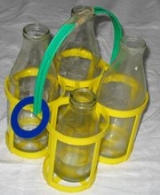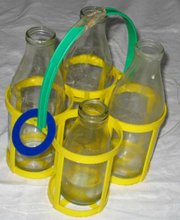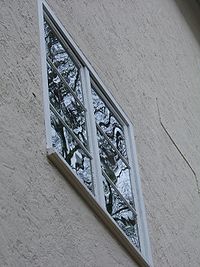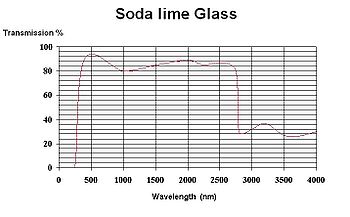
Soda-lime glass
Encyclopedia


Glass
Glass is an amorphous solid material. Glasses are typically brittle and optically transparent.The most familiar type of glass, used for centuries in windows and drinking vessels, is soda-lime glass, composed of about 75% silica plus Na2O, CaO, and several minor additives...
, used for windowpanes, and glass containers (bottles and jars) for beverages, food, and some commodity items. Glass bakeware
Cookware and bakeware
Cookware and bakeware are types of food preparation containers commonly found in the kitchen. Cookware comprises cooking vessels, such as saucepans and frying pans, intended for use on a stove or range cooktop. Bakeware comprises cooking vessels intended for use inside an oven...
is often made of tempered
Toughened glass
Toughened or tempered glass is a type of safety glass processed by controlled thermal or chemical treatments to increase its strength compared with normal glass. Tempering creates balanced internal stresses which cause the glass, when broken, to crumble into small granular chunks instead of...
soda-lime glass.
Soda-lime glass is prepared by melting the raw materials, such as sodium carbonate
Sodium carbonate
Sodium carbonate , Na2CO3 is a sodium salt of carbonic acid. It most commonly occurs as a crystalline heptahydrate, which readily effloresces to form a white powder, the monohydrate. Sodium carbonate is domestically well-known for its everyday use as a water softener. It can be extracted from the...
(soda), lime, dolomite
Dolomite
Dolomite is a carbonate mineral composed of calcium magnesium carbonate CaMg2. The term is also used to describe the sedimentary carbonate rock dolostone....
, silicon dioxide
Silicon dioxide
The chemical compound silicon dioxide, also known as silica , is an oxide of silicon with the chemical formula '. It has been known for its hardness since antiquity...
(silica), aluminium oxide
Aluminium oxide
Aluminium oxide is an amphoteric oxide with the chemical formula 23. It is commonly referred to as alumina, or corundum in its crystalline form, as well as many other names, reflecting its widespread occurrence in nature and industry...
(alumina), and small quantities of fining agents (e.g., sodium sulfate
Sodium sulfate
Sodium sulfate is the sodium salt of sulfuric acid. When anhydrous, it is a white crystalline solid of formula Na2SO4 known as the mineral thenardite; the decahydrate Na2SO4·10H2O has been known as Glauber's salt or, historically, sal mirabilis since the 17th century. Another solid is the...
, sodium chloride
Sodium chloride
Sodium chloride, also known as salt, common salt, table salt or halite, is an inorganic compound with the formula NaCl. Sodium chloride is the salt most responsible for the salinity of the ocean and of the extracellular fluid of many multicellular organisms...
) in a glass furnace at temperatures locally up to 1675 °C. The temperature is only limited by the quality of the furnace superstructure material and by the glass composition. Green and brown bottles are obtained from raw materials containing iron oxide
Iron oxide
Iron oxides are chemical compounds composed of iron and oxygen. All together, there are sixteen known iron oxides and oxyhydroxides.Iron oxides and oxide-hydroxides are widespread in nature, play an important role in many geological and biological processes, and are widely utilized by humans, e.g.,...
. Relatively inexpensive minerals such as trona
Trona
Trona ; Na3•2H2O is an evaporite mineral. It is mined as the primary source of sodium carbonate in the United States, where it has replaced the Solvay process used in most of the rest of the world for sodium carbonate production.- Etymology :The word "trona" comes to English by way of either...
, sand
Sand
Sand is a naturally occurring granular material composed of finely divided rock and mineral particles.The composition of sand is highly variable, depending on the local rock sources and conditions, but the most common constituent of sand in inland continental settings and non-tropical coastal...
, and feldspar
Feldspar
Feldspars are a group of rock-forming tectosilicate minerals which make up as much as 60% of the Earth's crust....
are used instead of pure chemicals. The mix of raw materials is termed batch.
Soda-lime glass is divided technically into glass used for windows, called float glass
Float glass
Float glass is a sheet of glass made by floating molten glass on a bed of molten metal, typically tin, although lead and various low melting point alloys were used in the past. This method gives the sheet uniform thickness and very flat surfaces. Modern windows are made from float glass...
or [flat glass], and glass for containers, called container glass
Container glass
Container glass is a type of glass for the production of glass containers, such as bottles, jars, drinkware, and bowls. Container glass stands in contrast to flat glass and fiberglass...
. The two types differ in the application, production method (float process
Float glass
Float glass is a sheet of glass made by floating molten glass on a bed of molten metal, typically tin, although lead and various low melting point alloys were used in the past. This method gives the sheet uniform thickness and very flat surfaces. Modern windows are made from float glass...
for windows, blowing and pressing for containers), and chemical composition (see table below). Float glass has a higher magnesium oxide
Magnesium oxide
Magnesium oxide , or magnesia, is a white hygroscopic solid mineral that occurs naturally as periclase and is a source of magnesium . It has an empirical formula of and consists of a lattice of Mg2+ ions and O2– ions held together by ionic bonds...
and sodium oxide
Sodium oxide
Sodium oxide is a chemical compound with the formula Na2O. It is used in ceramics and glasses, though not in a raw form. Treatment with water affords sodium hydroxide....
content than container glass, and a lower silica, calcium oxide
Calcium oxide
Calcium oxide , commonly known as quicklime or burnt lime, is a widely used chemical compound. It is a white, caustic, alkaline crystalline solid at room temperature....
, and aluminium oxide
Aluminium oxide
Aluminium oxide is an amphoteric oxide with the chemical formula 23. It is commonly referred to as alumina, or corundum in its crystalline form, as well as many other names, reflecting its widespread occurrence in nature and industry...
content. From this follows the slightly higher quality of container glass for chemical durability against water (see table), which is required especially for storage of beverages and food.
Typical compositions and properties
The following table lists some physical properties of soda-lime glasses. Unless otherwise stated, the glass compositions and many experimentally determined properties are taken from one large study. Those values marked in italic font have been interpolated from similar glass compositions (see calculation of glass propertiesCalculation of glass properties
The calculation of glass properties is used to predict glass properties of interest or glass behavior under certain conditions without experimental investigation, based on past data and experience, with the intention to save time, material, financial, and environmental resources, or to gain...
) due to the lack of experimental data.

| Properties | Soda-lime glass for containers Container glass Container glass is a type of glass for the production of glass containers, such as bottles, jars, drinkware, and bowls. Container glass stands in contrast to flat glass and fiberglass... |
Soda-lime glass for window Window A window is a transparent or translucent opening in a wall or door that allows the passage of light and, if not closed or sealed, air and sound. Windows are usually glazed or covered in some other transparent or translucent material like float glass. Windows are held in place by frames, which... s |
|---|---|---|
| Chemical composition, wt% |
74 SiO2 Silicon dioxide The chemical compound silicon dioxide, also known as silica , is an oxide of silicon with the chemical formula '. It has been known for its hardness since antiquity... , 13 Na2O Sodium oxide Sodium oxide is a chemical compound with the formula Na2O. It is used in ceramics and glasses, though not in a raw form. Treatment with water affords sodium hydroxide.... , 10.5 CaO Calcium oxide Calcium oxide , commonly known as quicklime or burnt lime, is a widely used chemical compound. It is a white, caustic, alkaline crystalline solid at room temperature.... , 1.3 Al2O3 Aluminium oxide Aluminium oxide is an amphoteric oxide with the chemical formula 23. It is commonly referred to as alumina, or corundum in its crystalline form, as well as many other names, reflecting its widespread occurrence in nature and industry... , 0.3 K2O Potassium oxide Potassium oxide is an ionic compound of potassium and oxygen. This pale yellow solid, the simplest oxide of potassium, is a rarely encountered, highly reactive compound... , 0.2 SO3 Sulfur trioxide Sulfur trioxide is the chemical compound with the formula SO3. In the gaseous form, this species is a significant pollutant, being the primary agent in acid rain. It is prepared on massive scales as a precursor to sulfuric acid.-Structure and bonding:Gaseous SO3 is a trigonal planar molecule of... , 0.2 MgO Magnesium oxide Magnesium oxide , or magnesia, is a white hygroscopic solid mineral that occurs naturally as periclase and is a source of magnesium . It has an empirical formula of and consists of a lattice of Mg2+ ions and O2– ions held together by ionic bonds... , 0.04 Fe2O3 Iron(III) oxide Iron oxide or ferric oxide is the inorganic compound with the formula Fe2O3. It is one of the three main oxides of iron, the other two being iron oxide , which is rare, and iron oxide , which also occurs naturally as the mineral magnetite. As the mineral known as hematite, Fe2O3 is the main... , 0.01 TiO2 Titanium dioxide Titanium dioxide, also known as titanium oxide or titania, is the naturally occurring oxide of titanium, chemical formula . When used as a pigment, it is called titanium white, Pigment White 6, or CI 77891. Generally it comes in two different forms, rutile and anatase. It has a wide range of... |
73 SiO2, 14 Na2O, 9 CaO, 4 MgO, 0.15 Al2O3, 0.03 K2O, 0.02 TiO2, 0.1 Fe2O3 |
| Viscosity Viscosity Viscosity is a measure of the resistance of a fluid which is being deformed by either shear or tensile stress. In everyday terms , viscosity is "thickness" or "internal friction". Thus, water is "thin", having a lower viscosity, while honey is "thick", having a higher viscosity... log(η, dPa·s or Poise) = A + B / (T in °C − To) |
550–1450°C: A = −2.309 B = 3922 To = 291 |
550–1450°C: A = −2.585 B = 4215 To = 263 |
| Glass transition temperature, Tg, °C |
573 | 564 |
| Coefficient of thermal expansion, ppm/K, ~100-300°C |
9 | 9.5 |
| Density Density The mass density or density of a material is defined as its mass per unit volume. The symbol most often used for density is ρ . In some cases , density is also defined as its weight per unit volume; although, this quantity is more properly called specific weight... at 20°C, g/cm3 |
2.52 | 2.53 |
| Refractive index Refractive index In optics the refractive index or index of refraction of a substance or medium is a measure of the speed of light in that medium. It is expressed as a ratio of the speed of light in vacuum relative to that in the considered medium.... nD at 20°C |
1.518 | 1.520 |
| Dispersion Dispersion (optics) In optics, dispersion is the phenomenon in which the phase velocity of a wave depends on its frequency, or alternatively when the group velocity depends on the frequency.Media having such a property are termed dispersive media... at 20°C, 104×(nF−nC) |
86.7 | 87.7 |
| Young's modulus Young's modulus Young's modulus is a measure of the stiffness of an elastic material and is a quantity used to characterize materials. It is defined as the ratio of the uniaxial stress over the uniaxial strain in the range of stress in which Hooke's Law holds. In solid mechanics, the slope of the stress-strain... at 20°C, GPa |
72 | 74 |
| Shear modulus at 20°C, GPa |
29.8 | 29.8 |
| Liquidus Liquidus temperature The liquidus temperature, TL or Tliq, is mostly used for glasses, alloys and rocks. It specifies the maximum temperature at which crystals can co-exist with the melt in thermodynamic equilibrium. Above the liquidus temperature the material is homogeneous... temperature Liquidus temperature The liquidus temperature, TL or Tliq, is mostly used for glasses, alloys and rocks. It specifies the maximum temperature at which crystals can co-exist with the melt in thermodynamic equilibrium. Above the liquidus temperature the material is homogeneous... , °C |
1040 | 1000 |
| Heat Heat capacity Heat capacity , or thermal capacity, is the measurable physical quantity that characterizes the amount of heat required to change a substance's temperature by a given amount... capacity Heat capacity Heat capacity , or thermal capacity, is the measurable physical quantity that characterizes the amount of heat required to change a substance's temperature by a given amount... at 20°C, J/(mol·K) |
49 | 48 |
| Surface tension Surface tension Surface tension is a property of the surface of a liquid that allows it to resist an external force. It is revealed, for example, in floating of some objects on the surface of water, even though they are denser than water, and in the ability of some insects to run on the water surface... , at ~1300°C, mJ/m2 |
315 | |
| Chemical durability, Hydrolytic class, after ISO 719 |
3 | 3...4 |
| Critical stress intensity factor, (KIC), MPa.m0.5 |
? | 0.75 |
- Coefficient of restitutionCoefficient of restitutionThe coefficient of restitution of two colliding objects is a fractional value representing the ratio of speeds after and before an impact, taken along the line of the impact...
(glass sphere vs. glass wall): 0.97 ± 0.01 - Thermal conductivityThermal conductivityIn physics, thermal conductivity, k, is the property of a material's ability to conduct heat. It appears primarily in Fourier's Law for heat conduction....
: 0.9-1.3 W/m.K - Hardness (Mohs scale)Mohs scale of mineral hardnessThe Mohs scale of mineral hardness characterizes the scratch resistance of various minerals through the ability of a harder material to scratch a softer material. It was created in 1812 by the German geologist and mineralogist Friedrich Mohs and is one of several definitions of hardness in...
: 6 - Knoop hardnessKnoop hardness testThe Knoop hardness test is a microhardness test - a test for mechanical hardness used particularly for very brittle materials or thin sheets, where only a small indentation may be made for testing purposes...
: 585 kg/mm2 + 20

